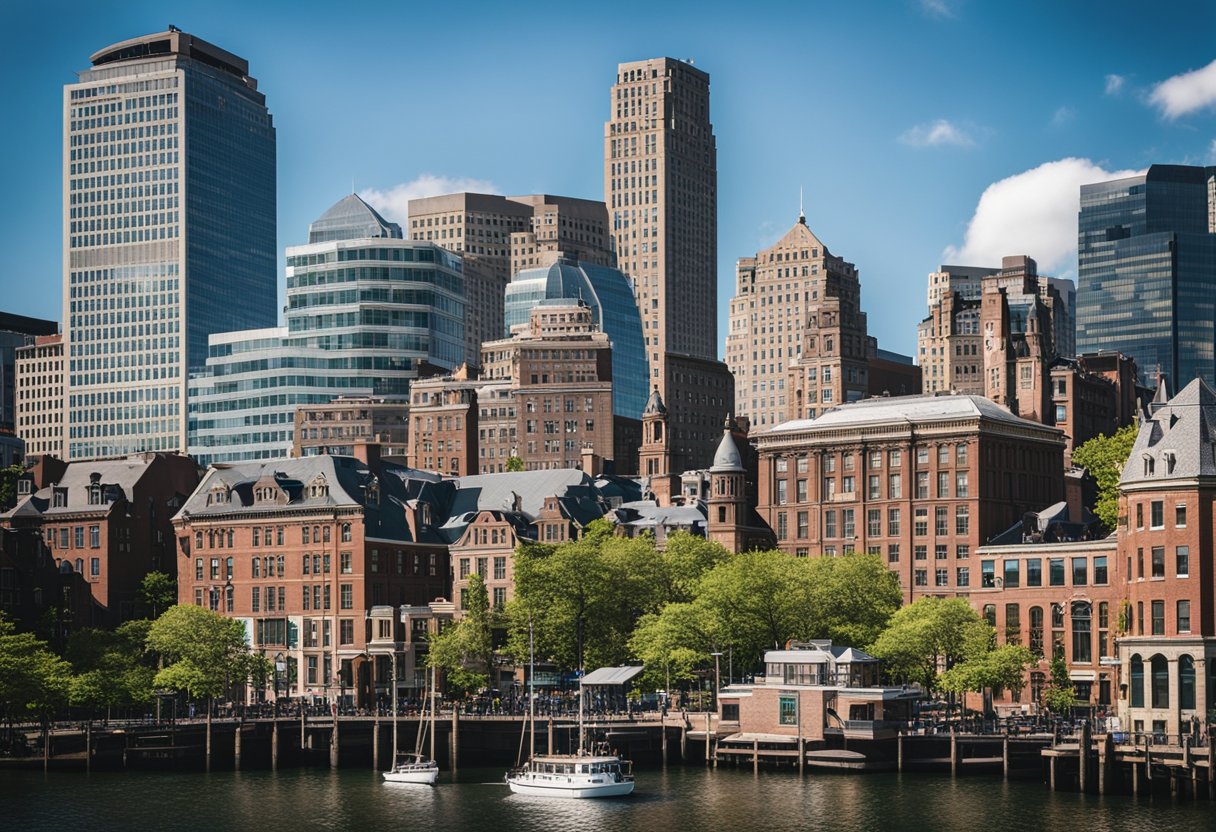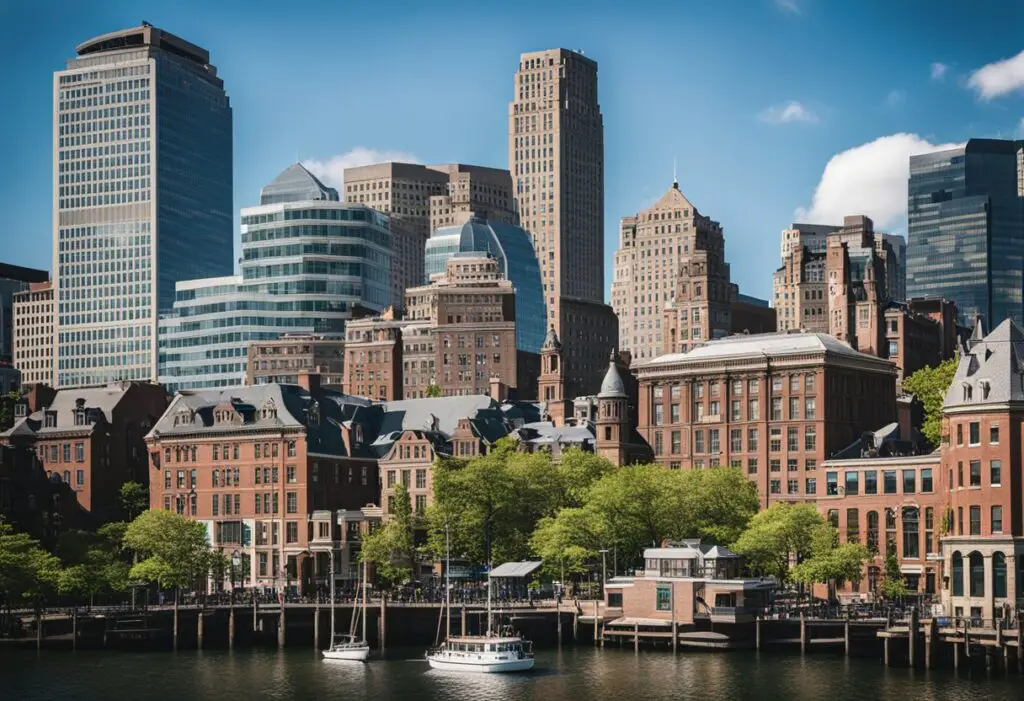
Boston, a city rich in history, diverse neighborhoods, and a thriving arts and culture scene, has long been a popular destination for tourists from around the world. As a visitor, you’ll be intrigued to learn more about the tourism statistics for this charming Massachusetts city, which can provide valuable insights into the local economy and travel trends.
In recent years, Boston has seen fluctuations in tourism numbers, with the industry facing significant challenges due to global events. However, it’s important to note that the city has a resilient tourism sector, supporting thousands of jobs and contributing substantially to the Massachusetts economy. By examining tourism statistics, you can gain a deeper understanding of Boston’s visitor landscape and make the most of your experience in this iconic city.
This article will take a closer look at Boston’s tourism industry, including its key attractions, transportation infrastructure, and hotel sector. It will also examine the impact of the COVID-19 pandemic on Boston tourism and the city’s recovery efforts.
On This Page
- Boston's Attractions: A Rich History and Diverse Culture
- Boston Tourism Overview: A Thriving Industry with Multifaceted Benefits
- Navigating Boston: Insights into Travel and Transportation Trends
- Checking In: A Closer Look at Accommodation Trends in Boston
- From Crisis to Comeback: Unpacking the Impact of COVID-19 on Boston Tourism
- Final Thoughts
Boston's Attractions: A Rich History and Diverse Culture
Boston is a city with a rich history and culture, and there is something for everyone to enjoy. From its historic sites and museums to its vibrant arts and sports scene, Boston has something to offer visitors of all ages and interests.
Here are some interesting facts about Boston and its attractions:
• Boston is one of the oldest cities in the United States, founded in 1630 by Puritan settlers from England.
• Boston is the only place in the world where a boat can sail under a train going under a car driving under an airplane. This is possible at the Boston University Bridge, which crosses the Charles River.
• Boston has more than 100 colleges and universities in the metropolitan area, making it a hub for higher education and research. Some of the most prestigious ones are Harvard University, Massachusetts Institute of Technology (MIT), and Boston University.
• Boston has approximately 47 miles of shoreline and 34 harbor islands.
• Freedom Trail: This is a 2.5-mile walk that takes you to 16 historic sites, such as the Old State House, the Paul Revere House, and the USS Constitution. You can learn about the American Revolution and the founding of Boston along the way.
• Fenway Park: This is the oldest original Major League baseball stadium still in use. It opened in 1912.
• Boston Common: Established in 1634, it’s the oldest public park in the country.
• The Prudential Center: Home of the Skywalk Observatory, it’s the second-tallest building in Boston.
• Boston Fire Department: Established in 1678, it’s the oldest fire department in the United States.
• Isabella Stewart Gardner Museum: More than $500 million worth of paintings were stolen from this museum in 1990.
• Old State House: The oldest surviving public building in Boston, dating back to 1713.
• The Peabody Essex Museum houses more than 550 original documents from the Salem witch trials of 1692.
• Museum of Fine Arts: This is one of the largest and most comprehensive art museums in the world. It has more than 450,000 works of art, ranging from ancient to contemporary. You can see masterpieces by Monet, Van Gogh, Picasso, and more here.
• In 2022, Boston National Historical Park attracted about 2.12 million visitors, making it one of the most visited national parks in the US.
• The Boston Convention and Exhibition Center hosted 336 events in 2019, with an aggregate of 832,243 attendees, generating 800,000 hotel room nights and $870 million in economic impact.
Boston is a vibrant and exciting city with something to offer everyone. Visitors can enjoy its rich history, culture, and sports scene, as well as its diverse culinary and arts scene. With so much to see and do, Boston is a great place to visit for a weekend or a week.
Sources: Wikipedia, Statista, TravelUSNews, TrolleyTours, GoCity, FactRetriever, TravelExperta, TheCultureTrip, Bostoday6amcity.
Boston Tourism Overview: A Thriving Industry with Multifaceted Benefits
Boston, the vibrant heart of Massachusetts, has not only played a pivotal role in American history but has also become a dynamic hub for tourism. The statistics surrounding Boston’s tourism industry tell a compelling story of economic prosperity, diverse employment opportunities, and international allure.
Next, we unveil the numbers that depict the vital role that tourism plays in Boston’s economic landscape, showcasing how it both shapes and is shaped by this historic city.
• According to the Massachusetts Office of Travel & Tourism (MOTT), direct spending by domestic and international visitors in Massachusetts totaled $24.2 billion in 2018, which supported 153,200 jobs and generated $1.6 billion in state and local tax revenue.
• In 2019, Massachusetts hosted 26.8 million domestic visitors and 2.4 million international visitors.
• The majority of domestic visitors came from New England and the mid-Atlantic states, while the top international markets were Canada, China, the United Kingdom, Germany, and France.
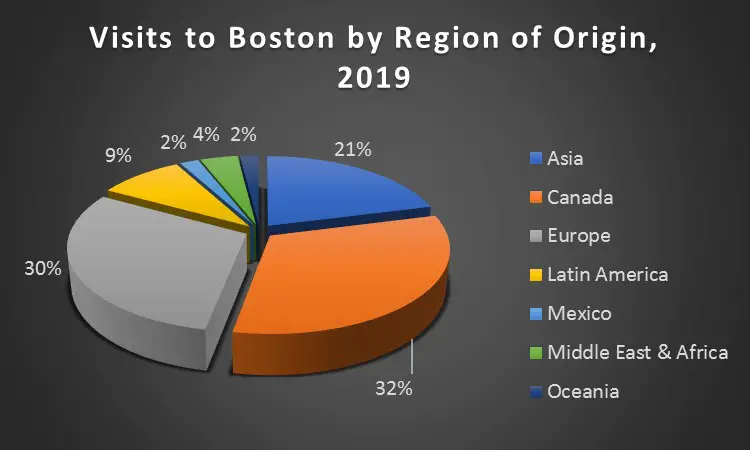
• In 2019, tourism ranked as the third-largest industry in Massachusetts. It serves as a crucial economic catalyst in Boston.
• Boston is the most popular destination in Massachusetts, attracting about 22.7 million visitors in 2019 including 2.7 million international visitors.
• Greater Boston contributes significantly to tourism, generating:
- $22.6 billion in economic output;
- $850 million in total state and local tax revenue;
- $318 million in occupancy tax revenue.
• The tourism and hospitality sector directly employs one out of every ten Massachusetts residents.
• It represents the most diverse workforce in the state.
• This industry offers flexible and accommodating employment opportunities.
• Between 2014 and 2019 international visitors spending to Boston increased by 19.7%.
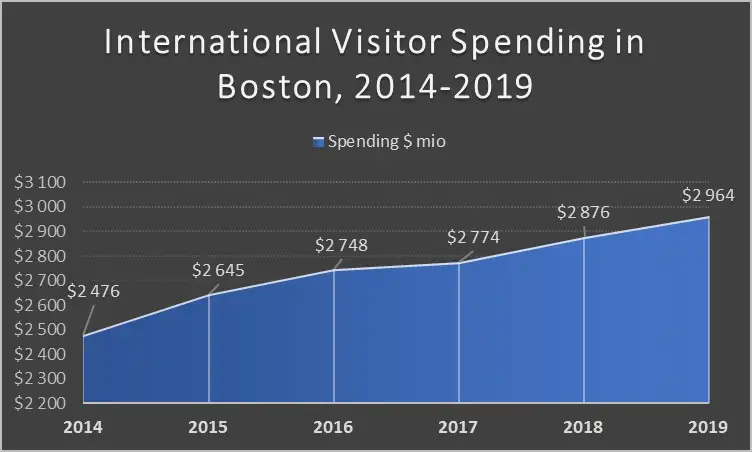
• The main reasons for visiting Boston are leisure, business, and education.
• The average length of stay for overnight visitors is 2.3 nights.
These statistics highlight the remarkable economic and cultural impact of tourism in this historic city. With millions of visitors from both near and far, Boston’s thriving tourism industry supports a diverse workforce, generates substantial economic output, and bolsters state and local tax revenues. As Boston continues to evolve, these numbers reinforce the city’s status as a prime destination for leisure, business, and education, underscoring its timeless appeal to a global audience.
Sources: MeetBoston 1, WCVB, VisitMA 1, VisitMA 2, MeetBoston 2.
Navigating Boston: Insights into Travel and Transportation Trends
The city of Boston, renowned for its historical significance and vibrant culture, is also a bustling hub of transportation and travel. Further statistics delve into the city’s travel and transportation landscape. From the oldest subway system in the United States to the impact of the COVID-19 pandemic on Logan International Airport, we explore the numbers that underpin the ways people move in and around this iconic city.
• Boston “T” System: The oldest subway system in America, built in 1897.
• The MBTA provides public transportation to 175 cities and towns in eastern Massachusetts.
• The MBTA served about 1.2 million passengers every weekday prior to the COVID-19 pandemic.
• As of November 2020, the MBTA served approximately 368,000 passengers per weekday.
• 36% of households in Boston do not have a vehicle.
• Logan International Airport is the most active airport in New England.
• In 2019, Logan served over 42.5 million international and domestic passengers.
• Total number of passengers in Logan Airport dropped to 12.6 million in 2020, a 70% decrease from 2019.
• Total number of flights, domestic and international, decreased 52% between 2019 and 2020.
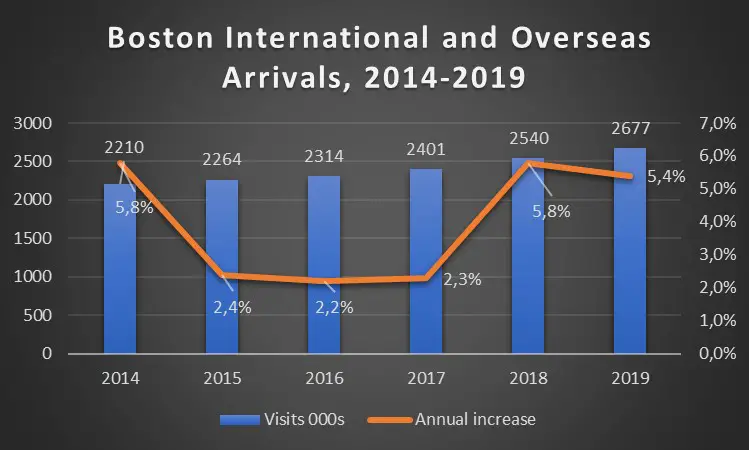
In conclusion, the intricate web of statistics that define Boston’s travel and transportation landscape showcases a city that embodies both a rich historical heritage and a dynamic modernity. The historical significance of the Boston “T” System, as the oldest subway system in America, stands as a testament to the city’s pioneering spirit. The MBTA’s extensive reach, serving millions of passengers before the pandemic, underscores its essential role in the daily lives of Bostonians.
Sources: GoCity, Boston.Gov.
Checking In: A Closer Look at Accommodation Trends in Boston
Accommodation in a bustling city like Boston is not just about providing a place to lay one’s head; it’s about weaving the fabric of the city’s hospitality industry.
Next, we delve into the statistics that unveil the dynamics of the accommodation sector in Boston. From the workforce it sustains to the challenges it faced during the pandemic and its anticipated resurgence, these numbers paint a vivid picture of how Boston’s hotels have evolved in recent years.
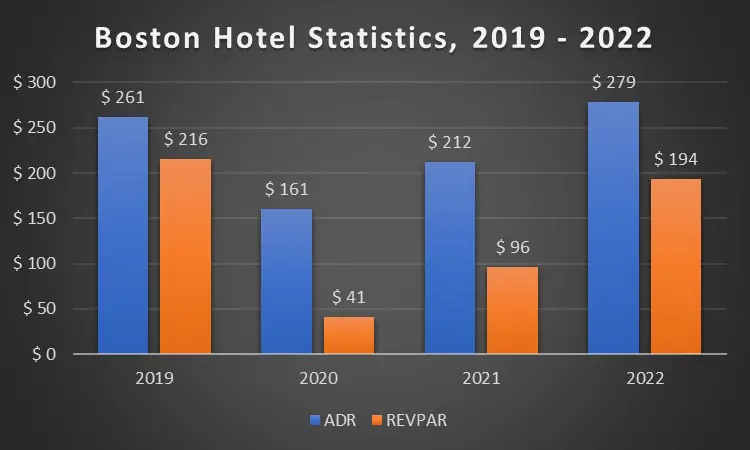
• The hotel industry in Boston provided 11,609 direct jobs in 2018.
• In 2020, Accommodation and Food Services jobs decreased by 39.7%, losing 24,871 jobs in total.
• As of January 2020, Boston had 93 hotels, with an average daily room rate of $269 per night.
• The average occupancy rate of hotels in Boston was 79.8% from 2009 through 2019.
• In 2019, the average hotel occupancy rate in Boston was 82%, which dropped to 25% in 2020 due to the COVID-19 pandemic. However, it is expected to rebound to 66% in 2023 as travel restrictions ease.
• The number of hotel rooms available in the city has grown over the last 10 years, from about 18,000 rooms to almost 23,000 rooms.
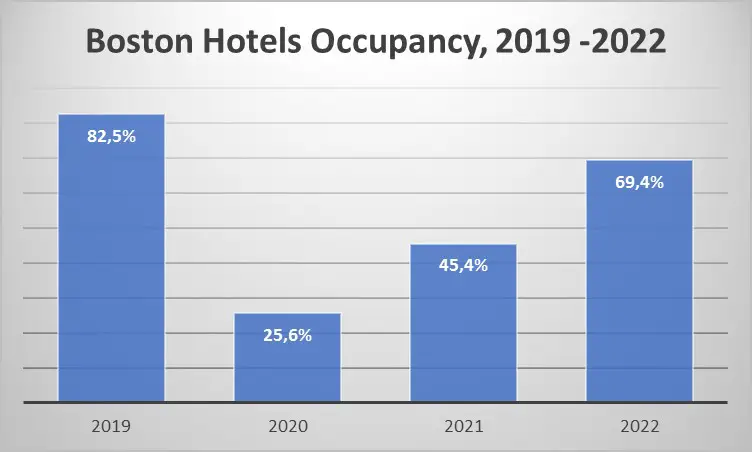
The data illuminating the state of accommodation in Boston paints a multifaceted picture of this dynamic industry. From providing thousands of jobs in 2018 to facing a substantial setback in 2020, Boston’s hospitality sector has experienced both highs and lows. The COVID-19 pandemic undoubtedly took a toll, but the anticipated rebound in occupancy rates by 2023 reflects the city’s unwavering spirit and its ability to adapt to changing circumstances.
Sources: Boston.Gov, Axios.
From Crisis to Comeback: Unpacking the Impact of COVID-19 on Boston Tourism
The COVID-19 pandemic sent shockwaves through the global tourism industry, and Boston was no exception. In this section, we delve into the stark impact of the pandemic on Boston’s tourism landscape, as revealed by a series of telling statistics. From a drastic drop in visitor numbers and spending to the fluctuating hotel occupancy rates and the ebb and flow of visitors to historic sites, these numbers provide a sobering view of how Boston’s tourism was fundamentally reshaped by the unprecedented challenges of 2020.
• The number of visitors to Boston increased from 15.4 million in 2010 to 21.6 million in 2019, before dropping to 7.4 million in 2020 due to the COVID-19 pandemic.
• The visitor spending in Boston also rose from $7.2 billion in 2010 to $10.3 billion in 2019, before falling to $3.2 billion in 2020.
• The hotel occupancy rate in Boston fluctuated between 70% and 80% from 2010 to 2019, reaching a peak of 81.2% in 2018, before plunging to 33.3% in 2020.
• The number of flights and passengers at Logan International Airport increased from 316,000 flights and 27.4 million passengers in 2010 to 379,000 flights and 36.1 million passengers in 2019, before declining to 266,000 flights and 22.7 million passengers in 2020.
• The number of recreational visitors to Boston National Historical Park, which includes the Freedom Trail and other historic sites, varied between 1.5 million and 2.5 million from 2010 to 2019, reaching a high of 2.4 million in 2017, before dropping to 2.1 million in 2020.
The data presented in this section provides a compelling narrative of Boston’s resilience in the face of an extraordinary crisis. The precipitous drop in visitor numbers and spending in 2020, along with the fluctuating hotel occupancy rates and reduced flights at Logan International Airport, are stark reminders of the pandemic’s toll on the city’s tourism.
However, the anticipated rebound in tourism as travel restrictions ease presents hope for Boston’s future. Boston’s journey to recovery is a testament to its adaptability, and it reinforces the belief that the city will continue to shine as a vibrant and welcoming destination for tourists and history enthusiasts alike.
Sources: MeetBoston, VisitMA, Statista.
Final Thoughts
As we navigate the statistics that define Boston’s tourism landscape, it’s clear that this historic city remains an enduring and dynamic destination, offering a blend of historical heritage and modern vitality. Whether you’re drawn to its rich history, diverse cultural attractions, or educational opportunities, Boston continues to be a city that leaves a lasting impact on all who visit. So, when you plan your trip to Boston, rest assured that you are embarking on a journey to a city that has not only stood the test of time but has emerged stronger and more resilient, ready to provide a memorable experience for travelers from around the world.
See More Great Resources about Boston and Its Attractions:
Discover more about the culinary offerings in Boston:
Explore Details on Lodging Choices in Boston and Beyond:
Uncover Insights into Transportation in Boston:
